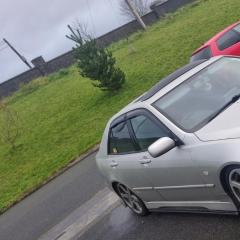-
Posts
81 -
Joined
-
Last visited
Profile Information
-
First Name
Jon
-
Gender
Male
-
Lexus Model
ISF
-
Year of Lexus
2008
-
UK/Ireland Location
Other/NonUK
-
Interests
Car Modification
Recent Profile Visitors
607 profile views
Jon Dee's Achievements
-
Well done !!! Always a pleasure to read about the work of someone who actually knows what they are doing to diagnose and solve electrical dramas on CANbus cars 👍👍
-
OK... based on the facts as disclosed, the resistor is not the problem. Plus, bypassing the resistor should have applied 12V to the pump and the car would run at all times normally albeit with a little more noise from the pump as it would be running constantly at high speed. Therefore you must have a problem with your 12V supply to the pump. There is nothing in the simple on/off fuel pump control that can change the pump speed/supply voltage gradually. It should be either 12V or a fixed lower voltage as determined by the value of the resistor. If you check the temperature of the FP relay after you have been driving for a while, it should not be any more than hand warm. If it is too hot to hold your hand on then it is likely that the relay contacts have arcing corrosion and the relay should replaced. Replacing the relay will also eliminate the possibility of a dry solder joint inside the relay. I mention that as dry joints can be responsible for faults that require a "cool down" period before the engine can be re-started. It is a feature of DC motors driving a fixed load, that if the supply voltage is reduced the current drawn will increase. That accounts for the resistor getting hot as it is having to dissipate greater than its design wattage. I suggest you first check the power supply to the FP relay to make sure that it is getting a full 12V at all times. If so, the problem is with the relay or one of its wiring connections. Cheers...
-

Coilover spring rates
Jon Dee replied to jeffrosie6's topic in Lexus F Club - Lexus IS-F / GS-F / RC-F Club
Have you tried freeing them up with a hammer and pin punch ? Here are some 2008 ISF spring rates that I dredged up from the internet a while ago when I was looking to change coilovers.... -
Here is a bit of generic information on the operation of old school Toyota 2-speed fuel pumps. Sounds like the speed control is trying to do its stuff but you have an extra resistance somewhere. Bad connection or relay contacts are in need of a clean. Maybe even a dry solder joint as temperature is involved. Does that FP relay get REAL hot ? Cheers...
-
I'm wondering if by any chance the main ECU has reverse polarity protection. I was doing a bit of bench programming once on an aftermarket ECU using a 12V car battery as a power supply. I inadvertently got the leads crossed and BAM !!! Instant smoke as the insulation on my skinny test leads melted. On investigation it turned out that there was a sacrificial diode inside the box connected across the power supply. I had that replaced and the ECU was unharmed. Might be worth opening the ECU or at least testing it to see if it has a power supply to ground short circuit. I'd guess that reversed polarity in cars is a known hazard and the manufacturers might have provided some protection. Cheers...
-
This ^^^^ reply from Colin is sensible. I can only suggest that you go back and check every wire, plug, hose and fuse that you disturbed or disconnected for the installation. Make sure they are all correctly placed, firmly connected and undamaged. Check that any ground wires you moved are making good connections. Check if any rubber hose that you moved has not cracked, split or been accidentally disconnected.
-

Severe shuddering when braking between 40-60MPH
Jon Dee replied to robxenotech's topic in Brakes & Suspension
Rob, when you say that you changed the brakes, do you mean that you changed both the discs and pads, or did you just change the pads ? If it was just the pads, are the discs fairly well worn with a bit of a lip at the outside edge of the braking surface ? -
***** !!! I am having some trouble getting control of this post editor 🤬 However, as I was saying... a quick google indicates that an LS400 is likely to be factory fitted with this style of radiator. Alloy, core, plastic tanks and a transmission cooler inside the bottom tank. I don't know anything about the LS400, but if the pic is correct, then the radiator filler must be located remote from the radiator, and there will be an overflow hose connected to a spigot on the far end of the top tank. This general arrangement is a bit similar to that used on my 2008 ISF, and on the ISF there is a well known weak point... the overflow hose spigot. The plastic in the spigot where it is covered by the hose breaks down, and it is rare to find any 2008 ISF factory radiator where the overflow hose can be removed without the spigot crumbling and rendering the radiator useless. Not suggesting that the same issue would apply to the LS400, but it might be worth asking around in LS400 circles to see if it is a known problem. Cheers...
-

AGM or Flooded Cell 12v Battery
Jon Dee replied to stepppy's topic in Lexus NX300h / NX200t / NX350h / NX450h Club
It is important to use the same type of battery that the car was originally fitted with. AGM batteries require a higher charging voltage than standard lead-acid batteries. Putting an AGM battery into a car that has a charging system calibrated for a lead-acid battery means that the AGM battery will never be fully charged, reducing its capacity and shortening its life. So yeah, using a modern solid state charger that can detect the battery type is definitely a good move Cheers... -

Severe shuddering when braking between 40-60MPH
Jon Dee replied to robxenotech's topic in Brakes & Suspension
Jack the car up until the front wheels (wheel if you do one at a time) are off the ground. Rotate the wheel by hand and listen. If the disc has excessive runout you will hear a definite metallic rubbing sound that occurs with the valve stem (or a chalk mark) in the same position each time. If the runout is normal you will only hear a very light continuous rubbing sound, or a light rubbing that is present for most of the wheels rotation. If the runout is severe, the wheel maybe difficult to rotate and after half a rotation it will make a scraping noise and stop as if the brake had been applied lightly. If the runout is in spec then as mentioned above, and you didn't follow the approved "break-in" procedure for new discs and pads, you may have pad material transferred unevenly onto the surface of the disc. You will need to inspect the discs for uneven patches of discoloration. Excess pad material can usually be removed by flat sanding the braking surface, cleaning the disc with a spray-on brake cleaner, and repeating the correct break-in procedure. Post up what you find after inspecting your brakes. Cheers... -
Just ordered a couple of front screen side trim pieces for my ISF from Amayama, and the prices were around the same as the best Ebay prices, and cheaper than many. Amayama also quotes an all up delivered to door price inclusive of tax which takes any guesswork out of the equation. I like that a lot Cheers...
-

Ghost 2 Issues
Jon Dee replied to wheelysteve's topic in RX 300 / RX 350 / RX 400h / RX 200t / RX 450h Club
For a healthy charged battery to go flat overnight, there has to be a decent parasitic load. Something like a light, fan, fuel or water pump, or screen heater. Most of these loads will either shut down automatically or sound a warning when you exit the car. So the only suggestion I can come up with is to carefully check around the car using eyes and ears to see if you can detect anything that continues to operate after you have shut down the car. Cheers... -
Ever since I have had two cars, one daily driver and one "hobby" car that seldom gets driven, I have had battery problems. I get 5 to 8 years out of a battery in a daily driver, but different hobby cars have killed batteries in less than a year. The only solution I have found is to use the car more often to keep the battery charge up, or use a maintainer. Presently I have a solar panel charger set up inside the garage window, and hook that up to the car whenever it is parked up for more than a couple of days. Haven't had to jump start the car or replace a battery for the last five years :) There are multiple possible reasons for electrical "gremlins". But if all systems on the car work correctly when the engine is running and the alternator is charging, then low battery voltage/capacity is the most likely cause of problems when the car has been parked up for a day or two. This chart will give you an idea of the resting voltage you should read when using your multimeter between the posts on your battery. A new battery will get you into the green zone, but a battery that has been used for a while will spend most of its time hovering between the green and orange zones... at least that is what I have found !!! Cheers...
-
Car batteries are not not a "deep cycle" design, and don't like being being run flat. In particular they don't like being run dead flat. Do that a few times and the battery will lose a substantial percentage of its ability to hold a charge. What then happens is that the battery only takes a "surface charge"... shows that it is fully charged as soon as you hook your charger up or use a multimeter across the terminals. Put it back in the car and it will give up on the first cranking attempt. I had this problem, and managed to salvage the battery for a while by running a "rejuvenation" program on my charger, and then load testing it with 12V bulb to see how long it would power the bulb before dropping the voltage down to 10V. Fortunately, the car I had at the time had a protection function that progressively turned off systems that drained power as the battery voltage dropped towards 10V while the car was OFF. This function ensured that there was always enough left in the battery to ensure it would start, unless it was left too long without the car being driven for a decent distance. But forever after, if the car hadn't been used for a few days, when I went to use it the clock would be off. That meant that that the battery storage capacity had been seriously reduced, and required a very expensive replacement. Sold the car with the old battery but did warn the buyer to either use it daily or get a maintainer if it was not going to be used for a week. Cheers...









